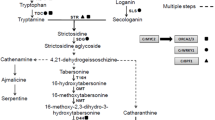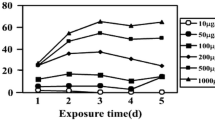Abstract
In the leaf of rice (Oryza sativa L.) cultivar Yunnan purple rice, the anthocyanins with an obvious absorption peak at 530nm were distributed in the cells of upper and lower epidermis, bulliform tissue and bristle. The maximal photosynthetic oxygen evolution rate and chlorophyll content in flag leaves were 28% and 23%, respectively, more than the common green leaf rice cultivar Chijiaoruanzhan. Higher chlorophyll content is probably one of the physiological adaptations for enhancing light harvesting capacity of the antenna in photosystems in this cyanic leaves species. Upon the photooxidation of leaf segments mediated by methyl viologen in weak light for 3 days, the distinct bleaching of anthocyanins in purple rice was associated with the reduction of scavenging ability to DPPH · free radical ability and the increase in membrane leakage rate. But almost no changes in contents of flavonoids and total phenolics were observed. Chlorophyll fluorescence parameters Fv/Fo, qP and ϕPSII decreased with the increase in NPQ and DES of xanthophylls cycle after photooxidation treatment. Green rice leaves showed more decrease in DPPH · scavenging rate and more increase in cell membrane leakage rate but showed a trace of anthocyanins during photooxidation. It is suggested that anthocyanin may be a beneficial and primary antioxidant in sun cyanic rice leaves against oxidative stress induced by environmental adversity. And photooxidation could induce different changing patterns of anthocyanins between the tested purple and green rice leaves.
Similar content being viewed by others
References
Moyer R A, Hummer K E, Finn C E, et al. Anthocyanins, phenolics, and antioxidant capacity in diverse small fruits: Vaccinium, Rubus, and Ribes. J Agric Food Chem, 2002, 50: 519–525
Yamasaki H, Uefuji H, Sakihama Y. Bleaching of the red anthrocyanin induced by superoxide radical. Arch Biochem Biophys, 1996, 332: 183–186
Shirley B W. Flavonoid biosynthesis: “New” functions for an “old” pathway. Trend Plant Sci, 1996, 1: 377–382
Chalker-Scott L. Environmental significance of anthocyanins in plant stress responses. Photochem Photobiol, 1999, 70: 1–9
Tsuda T, Shiga K, Ohshima K, et al. Inhibition of lipid peroxidation and the active oxygen radical scavenging effect of anthocyanin pigment isolated from Phaseolus vulgaris L. Biochem Pharacol, 1996, 52: 1033–1039
Bors W, Michel C, Saram, M. Flavonoid antioxidant: rate constants for reactions with oxygen radicals. Methods Enzymol, 1994, 234: 420–429
Smillie R M, Hetherington S E. Photoabatement by anthocyanin shields photosynthetic systems from light stress. Photosynthetica, 1999, 36: 451–463
Takahshi A, Takeda K, Ohnishi T. Light-induced anthocyanin reduces the extent of damage to DNA in UV-irradiated Centaurea cyanus cells in culture. Plant Cell Physiol, 1991, 32: 541–547
Gould K S, Mckelvie J, Morrkham K R. Do anthocyanins function as antioxidants in leaves? Imaging of H2O2 in red and green leaves after mechanical injury. Plant Cell Environ, 2002, 45: 1261–1269
Neill S O, Gould K S, Kilmartin P A, et al. Antioxidant activities of red versus green leaves in Elatostema rugosum. Plant Cell Environ, 2002, 25: 539–547
Merzlyak M N, Chivkunova O B. Light-stress-induced pigment changes and evidence for anthocyanin photoprotection in apples. J Photochem Photobiol, 2000, 55: 155–163
Gould K S, Kuhn D N, Lee D W, et al. Why leaves are sometimes red. Nature, 1995, 378: 241–242
Field T S, Lee D W, Holbrooks N M. Why leaves turn red in autumn. The role of anthocyanins in senescing leaves of red-osier dogwood. Plant Physiol, 2001, 127: 566–574
Neill S O, Gould K S, Kilmartin P A, et al. Antioxidant capacities of green and cyanic leaves in the sun species, Quintinia serrata. Funct Plant Biol, 2002, 29: 1437–14443
Gould K S, Markham K R, Smith R H, et al. Functional role of anthocyanins in the leaves of Quintinia serata A Cunn. J Exp Bot, 2000, 51: 1107–1115
Nogues S, Baker N R. Effects of drought on photosynthesis in Mediterranean plants grown under enhanced UV-B radiation. J Exp Bot, 2000, 51: 1309–1317
Reddy V S, Dash S, Reddy A R. Anthocyanin pathway in rice (Oryza sativa L.): identification of a mutant showing dominant inhibition of anthocyanins in leaf and accumulation of proanthocyanins in pericarp. Theor Appl Genet, 1995, 91: 301–312
Arnon D I. Copper enzymes in isolated chloroplasts polyenoloxidase in Beta valgaris. Plant Physiol, 1949, 24: 1–15
Tukumoto L R, Mazza G. Assessing antioxidant and prooxidant activities of phenolic compounds. J Agric Food Chem, 2000, 48: 3597–3604
Peng C L, Chen S W, Lin Z F, et al., Detection of antioxidative capacity in plants by scavenging organic free radical DPPH ·. Prog Biochem Biophys, 2000, 27(6): 658–661
Genty B, Briantais J M, Baker N R. The relationship between quantum yield of photosynthetic electron transport and quenching of chlorophyll fluorescence. Biochim Biophys Acta, 1989, 990: 87–92
Demmig-Adams B, Adam III W W, Barker D H, et al. Using chlorophyll fluorescence to assess the fraction of absorbed light allocated to thermal dissipation of excess excitation. Physiol Plant, 1996, 98: 253–264
Gilmore A M, Yamamoto H Y. Resolutions of lutein and zeaxanthin using a non-encapped, lightly radiation. carbon-loaded C18 high-performance liquid chromatographic column. J Chromatogr, 1991, 543: 137–145
Wang H, Cao G, Prior R L. Oxygen radical absorbing capacity of anthocyanins. J Agric Food Chem, 1997, 45: 304–309
Duthie Crozier A. Plant-derived phenolic antioxidants. Current Opin Lipidol, 2000, 11: 43–47
Yokozawa T, Chen C P, Dong E, et al. Study on the inhibitory effect of tannins and flavonoids against the 1,1-diphenyl-2-picrylhydrazyl radical. Biochem Pharacol, 1998, 56: 213–222
Sun J, Nishio J N, Vogelmann T C. Green light drives CO2 fixation deep within leaves. Plant Cell Physiol, 1998, 39: 1020–1026
Burger J, Edwards G E. Photosynthetic efficiency, and photo-damage by UV and visible in red versus green leaf Coleus varieties. Plant Cell Physiol, 1996, 37(3): 395–399
Hikosaka K, Kato M C, Hirose T. Photosynthetic rate and partitioning of absorbed light energy in photoinhibited leaves. Physiol Plant, 2004, 121: 699–708
Author information
Authors and Affiliations
Corresponding author
Rights and permissions
About this article
Cite this article
Peng, C., Lin, Z., Lin, G. et al. The anti-photooxidation of anthocyanins-rich leaves of a purple rice cultivar. SCI CHINA SER C 49, 543–551 (2006). https://doi.org/10.1007/s11427-006-2022-1
Received:
Accepted:
Issue Date:
DOI: https://doi.org/10.1007/s11427-006-2022-1




